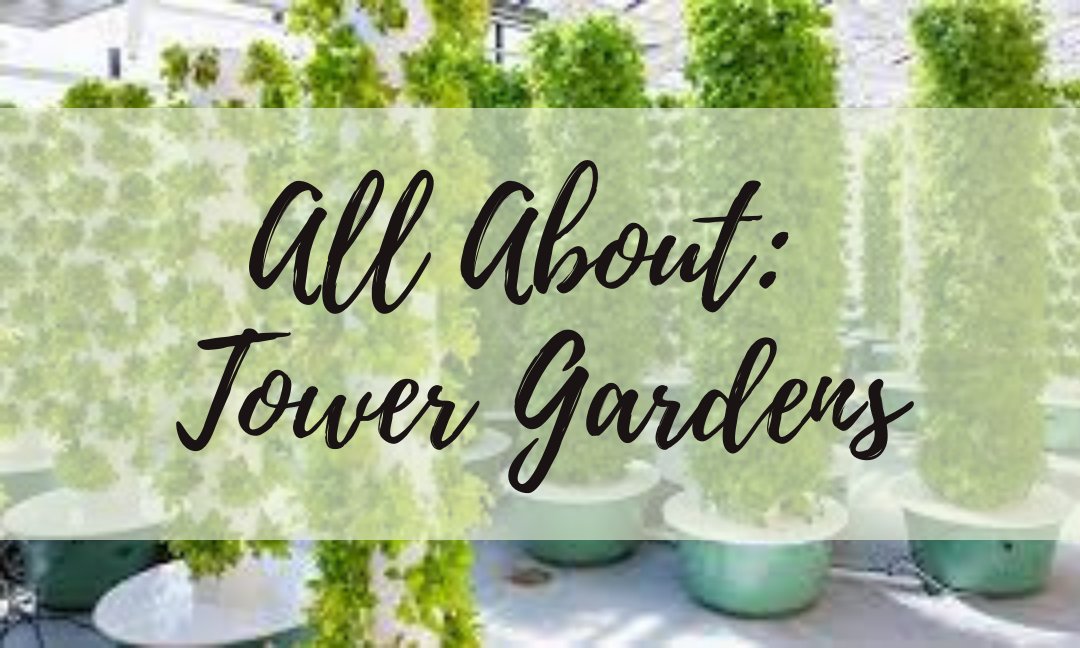Written by: Reva Grewal
The world of agriculture and gardening is rapidly evolving (Thrall et al, 2010). From genetically modified crops to new ways of watering crops, some of these changes have proven to increase efficiency in the agricultural industry (Thrall et al, 2010). These changes have made gardening more accessible for everyone. This post will be examining a way to cultivate an indoor garden, for those that may not have access to as much space but still wish to start a garden. So what is this so-called method of indoor growing? Let me introduce you to the Tower Garden. Various retailers provide this tool. This post will cover what a Tower Garden is with a summary of how it works, how it may prove helpful, and how you may acquire one.
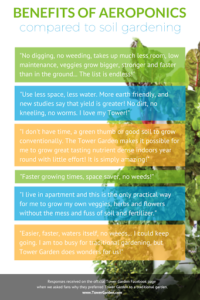
(5 research-backed benefits of Aeroponic gardening, n.d)
The Tower Garden is “a vertical, aeroponic growing system” (Grow food with a Vertical, Aeroponic System, n.d). Now, what does that mean? The vertical phrasing is about the tower part, as the actual base of it, while it varies between retailers, is less than three square feet (Grow food with a Vertical, Aeroponic System, n.d). Aeroponics (specialized hydroponics) consists of a plant’s roots growing whilst entirely suspended. Some tower gardens also use hydroponics (non-specialized). Aeroponics consists of spraying plants with nutrient-rich solution (water cascades down the tower) and hydroponics consists of submering plant roots in nutrient-rich water (Rural Living Gardening, 2020).
Both systems have their respective benefits and drawbacks. Aeroponic systems are good for growing leafy greens, vine plants, and herbs. Hydroponic systems grow more of a variety but may spread more diseases. Some advantages of aeroponics are high yields and improved plant health.
Some disadvantages are higher initial costs and difficult timing. In this case for hydroponics, some advantages are that it’s great for beginners and recycles water. A disadvantage is higher long-term costs. For a comprehensive view of the advantages and disadvantages of hydroponic vs aeroponic sources, I recommend this website: https://rurallivingtoday.com/hydroponics/aeroponics-vs-hydroponics/#What_Is_the_Difference_Between_Hydroponics_and_Aeroponics*.
A basic overview of how the Tower Garden aeroponic system works is that rock wool is placed in prospective pots (replaces soil), fill the Tower Garden reservoir with mineral blend and water for plants, and watch the water drip down to the plants through a pipe (using a timer and pump) (Discover aeroponic gardening. Tower Garden, n.d).
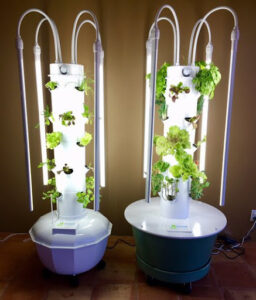
Tower Garden (Agrotonomy, n.d)
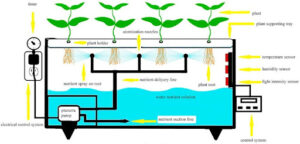
Computer-controlled aeroponics (Buttar, 2018)
There are plenty of reasons to invest in a Tower Garden as opposed to traditional methods of gardening. Using a Tower Garden takes up much less space than a traditional garden (5 research-backed benefits of Aeroponic gardening. n.d). Secondly, the Tower Garden can be used indoors, which means the crop yield is year-round. Thirdly, Tower Gardens use much less water than a traditional garden, which is both environmentally friendly and doesn’t break the bank! Tower Gardens don’t have any pesky weeds thanks to Rockwool! Additionally, there are fewer pesky pests which is music to the ears of those of us who don’t like creepy-crawlies. In general, there is less mess using this way of gardening, as there is no usage of soil and fewer pests overall (Foody, 2016).
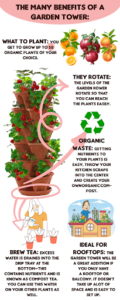
A visualization of the benefits of tower garden (Harper’s Nurseries, 2020)
Tower Gardens can be purchased from a multitude of locations, including Canada. Seedlings for Tower Gardens can be purchased from anywhere (do not have to be tower specific). Tower Gardens from reputable sites usually provide starter kits and thorough instructions that detail everything you need to know.
In conclusion, Tower Gardens are sustainable ways to grow crops. They may be pricey at first, but will quickly pay for themselves in the form of plants. Tower Gardens provide benefits such as attracting fewer pests, taking up less space, and saving water. Happy gardening!
Sources
5 research-backed benefits of Aeroponic gardening. Juice PLUS+. (n.d.).
https://www.towergarden.com/blog.read.html/en/2015/4/5_research-backedbe.html.
Agrotonomy. (n.d.). Europe-tower-garden-aeroponic. Tower Farms
https://agrotonomy.com/residential/.
Buttar, N. A. (2018). Figure 1. ResearchGate.
Discover aeroponic gardening. Tower Garden. (n.d.).
https://www.towergarden.com/aeroponics.
FAQs. Tower Garden. (n.d.).
Foody. (2016, August 9). 10 benefits of “GOING Vertical” with a hydroponic garden. Foody Vertical Gardens.
https://foodyverticalgarden.com/blogs/resources/10-reasons-to-try-vertical-hydroponic-gardening.
Grow food with a Vertical, Aeroponic System. Tower Garden. (n.d.).
https://www.towergarden.ca/tg.
Harper’s Nurseries. (2020). The Many Benefits of a Garden Tower.
https://harpersnurseries.com/best/garden-tower-reviews/.
Reid, K. (2021, April 16). Global water crisis: Facts, faqs, and how to help.
https://www.worldvision.org/clean-water-news-stories/global-water-crisis-facts.
Rural Living Gardening. (2020, October 27). Aeroponics vs hydroponics – which is best? Rural Living Gardening | Hydroponics | Generators.
Thrall, P. H., Bever, J. D., & Burdon, J. J. (2010). Evolutionary change in agriculture: the past, present and future. Evolutionary applications, 3(5-6), 405–408.
https://doi.org/10.1111/j.1752-4571.2010.00155.x
Tower Farms. (n.d.). Advantages of vertical aeroponic farming with tower farms. Tower Farms.
https://www.towerfarms.com/us/en/advantages.
Whole Food. (n.d.). Tower garden Benefits. Whole Food Nutrition On the Go.

